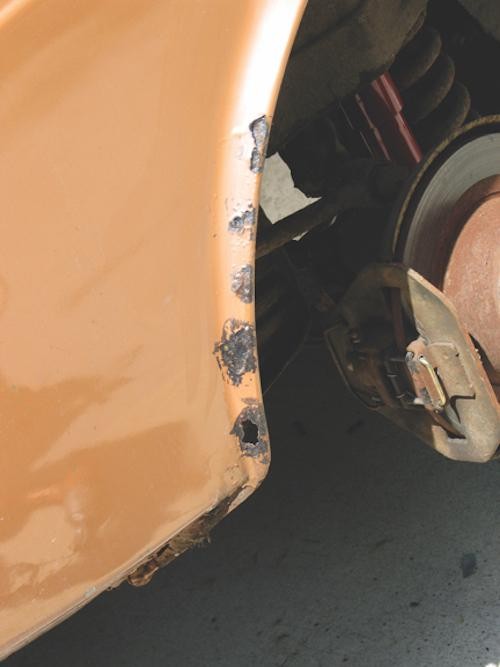Repairing rust or damage to your car’s sheet metal might seem daunting, but with the right tools and techniques, it’s a very achievable DIY project. Whether you’re dealing with minor rust spots or larger areas of damage, understanding how to repair sheet metal can save you money and keep your car looking its best. This guide will walk you through the process of repairing sheet metal on your car, focusing on using patch panels for effective and lasting repairs.
Before diving into the repair process, the first crucial step is to assess the damage. You need to determine whether the damaged panel should be repaired or entirely replaced. Bolt-on components like fenders, doors, and sunroofs are often easier to replace if the damage is extensive. Replacement can be a straightforward solution for these parts.
However, if the damaged panel is welded to the car’s body or if replacing the entire panel isn’t feasible, repairing the existing sheet metal becomes necessary. In this case, you’ll need to decide between using a pre-made patch panel designed for your car model or fabricating a patch from generic sheet metal. If a repair patch panel is available for your specific car and the damaged area, it’s generally recommended to use it. Pre-formed patch panels save significant time and effort compared to creating a patch from scratch.
In situations where a specific patch panel isn’t available, like in our example with the Saab 99 wheel arches, fabricating a patch from sheet metal is the way to go. Let’s get started on how to repair sheet metal using a fabricated patch.
Step 1: Preparing the Damaged Area
Initial rust damage on a car fender lip, requiring sheet metal repair.
Before you begin any repair work, it’s essential to thoroughly clean the area around the damage. This involves removing all traces of old paint, body filler, rust, and any other contaminants. A wire cup brush mounted on an angle grinder is an effective tool for this initial cleaning phase.
As you remove the layers of paint and filler, be prepared for the damage to potentially appear more extensive than initially visible. In our case, a seemingly small rust hole expanded as we removed layers of filler materials like Bondo and fiberglass. Always remember to wear appropriate safety gear, including eye and respiratory protection, during this and subsequent steps, as dust and debris will be generated.
Step 2: Removing Rust and Defining the Repair Area
Cleaning car sheet metal with a wire brush and angle grinder to prepare for repair.
After removing the initial layers of filler, switch to a grinding wheel on your angle grinder. This step is crucial for removing stubborn rust and shaping the damaged area into a clean, patchable form. The grinding wheel will effectively eliminate remaining rust and allow you to refine the edges of the damaged section.
Alternatively, tools like a plasma cutter, reciprocating saw, or die grinder can also be used to cut away the rusted metal. The goal is to cut back the sheet metal until you reach solid, rust-free metal around the entire perimeter of the hole. This clean, rust-free edge is essential for a strong and durable repair.
Step 3: Creating a Patch Panel Template
Creating a cardboard template for a custom sheet metal patch panel for car repair.
Creating an accurate patch panel is vital for a successful sheet metal repair. A practical approach is to first make a template out of cardboard. Start by cutting a piece of cardboard roughly larger than the area you need to patch. Then, carefully trim and shape the cardboard against the prepared opening on your car.
This iterative process of trial fitting and trimming the cardboard template will help you achieve the precise size and shape needed for your patch panel. Once you’re satisfied with the cardboard template’s fit, you can trace its outline onto your sheet metal. This traced outline will serve as your guide for cutting the actual patch panel from the sheet metal.
Step 4: Welding Equipment Selection for Sheet Metal
Selecting appropriate MIG welding equipment for automotive sheet metal repair work.
Choosing the right welding equipment is crucial for sheet metal repair. For automotive sheet metal work, MIG (Metal Inert Gas) welders are generally preferred due to their ease of use and ability to create clean welds on thinner materials. Depending on the specific job and your equipment availability, you might use different MIG welders. In this instance, a Daytona MIG 140-amp, 110-volt MIG welder was chosen.
Setting your welder to the correct power and wire speed is critical. For sheet metal, lower settings are typically required to prevent burning through the material. The example uses a setting of 2 out of 4 for power and approximately one-third wire speed from minimum on the Daytona welder. However, these settings are just starting points and can vary significantly based on your specific welder, the thickness of the sheet metal, and the type of welding wire. Always practice on scrap metal of similar thickness to find the optimal settings before welding on your car.
Step 5: Tack Welding the Patch Panel
Using tack welds to initially secure a sheet metal patch panel in place on a car body.
With your patch panel cut and welding equipment ready, the next step is to position and tack weld the patch into place. Wearing welding gloves for protection, hold the patch panel firmly over the prepared opening. Apply a single, solid tack weld to secure it in a starting position.
After the first tack weld, carefully check the patch panel’s alignment and fit. Make sure it’s correctly positioned and conforms to the shape of the surrounding panel. If necessary, gently bend or adjust the patch panel to achieve a good fit. Once satisfied with the positioning, apply additional tack welds around the perimeter of the patch. These tack welds should be spaced intermittently to hold the patch securely while preparing for the final welding.
Step 6: Stitch Welding for Panel Strength
Applying stitch welds to attach a sheet metal patch panel to a car, controlling heat buildup.
Once the patch panel is securely tack welded, proceed with stitch welding around its perimeter. Stitch welding involves creating a series of short, overlapping welds rather than one continuous bead. This technique is crucial in sheet metal repair because it minimizes heat buildup in any single area.
By jumping around and welding in short stitches, you reduce the risk of warping the sheet metal due to excessive heat. Warping can lead to distortions in the panel shape and increase the amount of body filler needed later to achieve a smooth finish. Stitch welding ensures a strong, continuous weld while controlling heat input and panel distortion.
Step 7: Grinding Down Welds for Smooth Finish
Grinding down weld beads on a car sheet metal patch to prepare for body filler and painting.
After completing the stitch welding, the welds will likely be raised and uneven. The next step is to grind down these welds to create a smoother surface. Using an angle grinder with a grinding disc, carefully grind down the weld beads. The objective is to knock down the high points of the welds and level the area as much as possible with the surrounding sheet metal.
Effective grinding at this stage minimizes the amount of body filler required in the subsequent steps of the bodywork process. By creating a smoother metal surface, you’ll achieve a cleaner and more professional-looking final repair.
Step 8: Protecting the Repaired Metal
Applying rust preventative metal treatment and etching primer to bare sheet metal after repair.
With the welding and grinding complete, you’re left with bare sheet metal. It’s crucial to protect this bare metal immediately to prevent rust from forming. The first step in protection is typically applying a phosphoric acid-based metal treatment, such as Ospho, to the entire repaired area and surrounding bare metal. This treatment converts any remaining rust and creates a protective layer.
Following the metal treatment, apply an etching primer. Etching primer is designed to adhere to bare metal and provide a foundation for subsequent layers of primer and paint. This two-step process of metal treatment and etching primer is essential to ensure long-term rust prevention and a durable finish on your sheet metal repair.
Conclusion
Repairing sheet metal on your car, while requiring patience and practice, is a rewarding skill. By following these steps, from assessing the damage to the final protective coatings, you can effectively repair rust and damage, extending the life and appearance of your vehicle. Remember to always prioritize safety, take your time, and practice your techniques to achieve professional-quality results in your DIY car sheet metal repairs.


